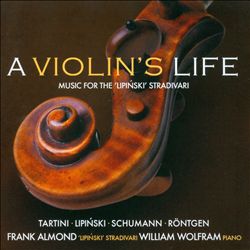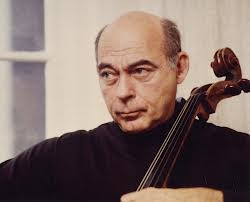Last week, one of my students pointed out that there is a violin playing grasshopper in James and the Giant Peach, the 1996 film based on the book by Roald Dahl. Here is a scene from the movie. If you’re familiar with this scene and you’ve always wondered what the grasshopper is playing, it’s the Gavotte en Rondeau from Bach’s Partita No. 3. Here is a great performance by violinist Ilya Kaler:
Timothy Judd
"A Violin’s Life" by Frank Almond
 Violinist Frank Almond has come out with an exciting new recording which I highly recommend. A Violin’s Life: Music for the ‘Lipinski’ Stradivari was released on April 19, debuting on Billboard’s Top Ten Classical list. Almond is the concertmaster of the Milwaukee Symphony Orchestra and a faculty member at Northwestern University. He is accompanied by pianist William Wolfram.
Violinist Frank Almond has come out with an exciting new recording which I highly recommend. A Violin’s Life: Music for the ‘Lipinski’ Stradivari was released on April 19, debuting on Billboard’s Top Ten Classical list. Almond is the concertmaster of the Milwaukee Symphony Orchestra and a faculty member at Northwestern University. He is accompanied by pianist William Wolfram.
Here is the interesting story of how the “Lipinski” Stradivari, one of the world’s finest violins, came into Frank Almond’s hands in 2008. A Violin’s Life celebrates this instrument by featuring music from its impressive history. The disk opens with the “Devil’s Trill” Sonata by Giuseppe Tartini (1692-1770), the violin’s first owner. Here is an excerpt:
Also included on A Violin’s Life is the rarely heard Violin Sonata No. 2 in F sharp, Op. 20 by Julius Rontgen (1855-1932), Caprice Op .29, No. 3 by the influential but largely forgotten violinist, Karol Lipinski (1790-1861) and Robert Schumann’s Violin Sonata No.2 in D minor, Op.121. I found the Rontgen reminiscent of the Brahms Sonatas. The Lipinski Caprice is a daredevil virtuoso adventure in double stops.
A Violin’s Life can be found on iTunes and at Amazon. For listeners who are interested in delving deeper into to the history of this music and the “Lipinski” Strad, Frank Almond provides a website, aviolinslife.org. He introduces the CD and provides further samples here:
It’s widely believed that the sound of a violin can be influenced and shaped by the performers who use it. The rich lineage of the “Lipinski” Strad is on full display in this recording as the past meets the future. A Violin’s Life will be a fascinating and enjoyable recording for all who love the violin.
Remembering Janos Starker

Cellist Janos Starker died yesterday in Bloomington, Indiana at the age of 88. You can read about his extraordinary career as a performer and teacher here and here. You may also be interested in this documentary.
Here is his recording of the opening movement of Bach’s Suite for Solo Cello, No. 1 in G Major:
https://www.youtube.com/watch?v=OtCkc8QneAw
This 1956 recording of the Dvorak Cello Concerto with the Philharmonia Orchestra and Walter Susskind is also remarkable:
https://www.youtube.com/watch?v=qLoAlwFTCLc
Here are the Second and Third Movements of the Dvorak. Find other Starker recordings on iTunes.
Baseball and the Symphony
A symphony is a dynamic, unfolding process. Within its formal structure small musical motives develop and evolve, constantly searching for an ultimate goal. On the largest level, the drama of a symphony might remind you of a baseball game. Through a series of exciting and unpredictable musical “plays,” it moves away from home and returns.
To get a sense of this drama, listen to the first movement of Mozart’s Symphony No. 40 (Molto allegro). Pay attention to the opening motive and how it develops. At the same time, can you perceive a larger formal structure?
Symphony No. 40 in G minor, K. 550…Wolfgang Amadeus Mozart (1756-1791)
[ordered_list style=”decimal”]
- Molto allegro -starts at 0:42
- Andante -starts at 8:28
- Menuetto. Allegretto-Trio -starts at 22:33
- Finale. Allegro assai -starts at 26:10
[/ordered_list]
https://www.youtube.com/watch?v=2HbMzu1aQW8
[typography font=”Cantarell” size=”28″ size_format=”px”]Motivic Development[/typography]
Could you hear the restless opening theme develop and search for a resolution? There are short term goals along the way, but the music never really rests until the final note. If you listen carefully, you’ll hear the opening theme pop up in unexpected places. For example, listen to the musical conversation between the clarinets and bassoons at 2:11. This motive is the seed from which the entire first movement grows. One musical cell spins to the next and every note seems inevitable. Motivic development is essential to the symphony, as Leonard Bernstein discusses in What Makes Music Symphonic?
[typography font=”Cantarell” size=”28″ size_format=”px”]Circling the Bases with Sonata Form[/typography]
This first movement is a great example of a common musical structure called sonata form. Conductor Robert Spano offers a brief and informal introduction to sonata form here. Also watch Leonard Bernstein’s What is Sonata Form?
Sonata form is made up of three main sections: the exposition, development and recapitulation. In the exposition, motivic material is introduced for the first time. We start out in a “home” key, but then begin to move away. The goal of the rest of the movement is to find a way back home. The development section is the most harmonically unstable. Here, the composer plays around with the motives, embellishing them in many adventurous ways. The recapitulation returns home. It’s the music of the exposition, but this time we must avoid being pulled to a new key.
Now, let’s go back and listen to the first movement again to hear sonata form at work in Mozart’s Symphony. Pay attention to the moment where the music moves aways from the home key of G minor (1:17). You’ll hear a second theme in B-flat major begin at 1:38. How is the mood of this theme different? The entire exposition repeats at 2:42. The development section starts at 4:33. Listen to the sneaky way Mozart slips back into the recapitulation (5:47).
[typography font=”Cantarell” size=”28″ size_format=”px”]Fast-Slow-Fast[/typography]
After you listen to the first movement a second time, go on to the other three movements. The classical symphony of Mozart and Haydn typically has a fast first movement, a slow second movement, a Minuet and a fast final movement. This fast-slow-fast structure evolved out of earlier opera overtures. You’ll hear that the second and final movements are built on sonata form. In the opening of the Andante, listen to the way Mozart seems to be searching for the right notes as voices build on top of each other. Here, as in the first movement, there is a sense of the music growing out of a motivic seed. Pay attention to the snappy rhythm that innocently enters in the violins at 9:06. What happens to this motive? Can you hear it begin to “infect” the music and take on a life of it’s own? The final movement is all about the fun of setting up our expectations and then throwing in a jarring surprise. Don’t miss the extraordinary and intense development section at 31:43.
If you would like to learn more about the origins and history of the symphony watch this recent BBC documentary. For a slightly contrasting interpretation of Mozart’s Symphony No. 40 you might be interested in hearing this performance by the Saint Paul Chamber Orchestra, conducted by Andreas Delfs. Recordings can also be found through iTunes and Amazon.
Music of Spring
Let’s celebrate the arrival of spring with a performance of Beethoven’s Violin Sonata No. 5 in F Major, Opus 24. Sometime after this music was published in 1801 it became know as the “Spring” sonata. Can you hear anything “springy” in the music?
As you listen, pay attention to the sense of dialogue between the violin and piano. What kind of a conversation are they having? Listen to the musical cat and mouse game that takes place in the Scherzo. The word “scherzo” translates as “joke.” I think you’ll hear the humor in this movement. A Rondo is a musical form in which a main theme keeps recurring, interspersed with short musical “adventures” into new territory.
This performance is by German violinist Anne Sophie Mutter and pianist Lambert Orkis:
[ordered_list style=”decimal”]
- Allegro -begins at 1:00
- Adagio molto espressivo –begins at 11:45
- Scherzo: Allegro molto -begins at 18:04
- Rondo: Allegro ma non troppo –begins at 19:29
[/ordered_list]
If you would like to hear a slightly different interpretation, listen to these recordings by Szeryng and Rubinstein, Oistrakh and Milstein. Is there one performance that stands out for you? If so, I’d be interested in hearing your thoughts.
Witches’ Dance
Suzuki violin students learn the theme from Witches’ Dance in Book 2. Here is the original piece by Niccolo Paganini (1782-1840).
Through his virtuosity, Paganini transformed violin playing. Audiences at the time were shocked by the new sounds and dazzling effects which he employed. He toured Europe garnering celebrity comparable to a modern day rock star.
Listen to this spectacular performance by Eugene Fodor. This clip is taken from his 1990’s recording, Witches’ Brew which features a collection of violin show pieces. You’ll recognize the Witches’ Dance theme at 3:20, followed by a series of variations featuring double stops (two pitches played at the same time) harmonics (a whistle-like sound effect produced by the finger touching the string lightly) left hand pizzicato, up bow staccato and more. It’s amazing how many different voices can be produced by a single violin, each bringing to life a unique personality.
Paganini’s music is infused with an elegance and Bel canto (“beautiful singing”) quality that may remind you of Italian opera.
Shinichi Suzuki on Video
Here are two short videos that show Shinichi Suzuki working with students. They offer a glimpse of the good humor and almost childlike joy for which Suzuki was known.
In the first clip Suzuki demonstrates the students’ ability to stop and start at any point in the last movement of the Bach A minor Concerto (Suzuki Violin Book 7). The game he uses reinforces the idea that you really know a piece well if you can start anywhere. Isolate and repeat small units of notes throughout the piece during practice to help to build this skill.
In the second clip Suzuki plays the piano and creates endless new variations to Twinkle, Twinkle Little Star, which the students repeat. Notice that he also tests them by changing the tempo here and there.
For anyone who is interested in some background on Suzuki’s life and how he developed the Suzuki method, here is an interesting clip.
Lincoln Portrait
In honor of Presidents’ Day, here is Lincoln Portrait by twentieth century American composer Aaron Copland. Listen to the way Copland combines music and Lincoln’s eloquent words to create a monument to the 16th president. Besides the use of popular early American songs like Camptown Races and Springfield Mountain, do you hear anything else in the music that seems distinctly American?
Listen to Copland talk about Lincoln Portrait and get some background on the piece here. You can find a recording on iTunes and Amazon.
Here is a great old recording with Eugene Ormandy and the Philadelphia Orchestra. Adlai Stevenson is the narrator:
https://www.youtube.com/watch?v=Cs6cIi_mKfg




